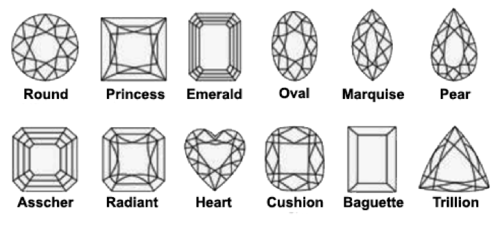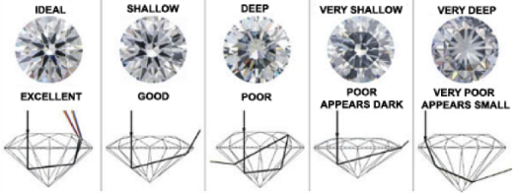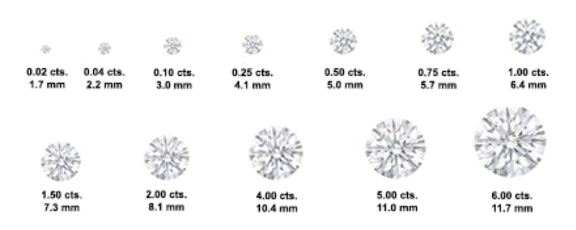Choosing a diamond is not only about comparing its price or its weight, it's about discovering the perfect combination of characteristics that better describe the ideal one for you. We know this is not an easy job, that's the reason why we'd like to share with you 3 questions you need to ask yourself to find out what you are looking for before buying a diamond. Start by answering to:
1. What shape I like the most?
First you have to know that not all diamonds are Round or Princess (the two most popular shapes in the market), there are also 10 more different forms between traditional and “fancy cuts” that can fulfill your desire. You'll have to choose among:
To learn more about the basic diamond shapes click here.
2. What characteristics am I looking for? (4Cs)
Each diamond has its own value given by its unique characteristics, all of these together will determine the final price of the stone. This characteristics established by the GIA (Gemological Institute of America), are the ones that classify the stones grading their cut, color, clarity and carat weight. In order for you to find your ideal diamond you must select the grading of the 4 value factors (4C’s) that better describe what you want.
- CUT
It qualifies the effectiveness of the light that enters into the stone and how it is reflected into your eyes. It also measures the angles, length and symmetry of the brilliant. A well-cut diamond is bright, radiant and full of life, it gives the impression to be bigger than stones with the same carat weight. It's brilliance is considered the most important characteristic among the 4Cs. The different cuts you can find are:

If you have no idea of what cut is better for you, we suggest you to look for something between an Excellent or Very Good cut so that your diamond can give away a beautiful light performance.
- COLOR
It grades the lack of color in the stone. The closest the diamond is to being colorless, the more expensive it gets; but when it comes to fancy colored stones, the closer it is to have a strong/hard color the higher its price. The color is graded within the next scale: It is pretty hard to differentiate a D color from an F since they are all colorless, but when it comes to D graded brilliants they are way to expensive and also hard to find. Also it is important for you to know that J graded stones still have a white look with very light yellow tones, that's why we recommend you buying diamonds between an E and a J color according to what better fits your budget.
It is pretty hard to differentiate a D color from an F since they are all colorless, but when it comes to D graded brilliants they are way to expensive and also hard to find. Also it is important for you to know that J graded stones still have a white look with very light yellow tones, that's why we recommend you buying diamonds between an E and a J color according to what better fits your budget.
- CLARITY
It measures the amount of inclusions in the stone or by the other hand, the absence of them. Some of these irregularities can be clouds, crystals, feathers, needles, pinpoints, among others. Many of these inclusions are microscopic and may not be visible to the naked eye, in that case the diamond is considered "eye clean", which means you are not able to identify the inclusions without a magnifying glass. The clarity is graded according to how pure or clean the stone is like in the following scale:

Flawless diamonds are extremely pure and also very hard to find. In Dídiamant we suggest our customers to look for something between VVS2 and SI2, into this range you may be able to find a beautiful shiny stone with great color that even if it has some inclusions on it, it still looks perfectly eye clean. Example: In some cases a FL stone and a good SI2 stone may look the same to the naked eye, the only difference can be seen by microscope and the difference in prices will be huge.
- CARATS
It refers to the total weight of the stone. Carats do not define its size; it depends on the distribution of its weight. The larger the diameter, the bigger the diamond will look; but this one can affect the cut and symmetry of the brilliant.
This is approximately the size of a diamond according to its carats:
3. Certified or Not?
The last question you need to answer is about the certification. If you want to make sure that your diamond is all natural you can decide weather to trust your jeweler or to look for certificated stones to make sure they are not treated, zirconias or so. To identify your diamond easily, you must know that some are signed up with a serial number that matches its certificate where you'll find information with the whole grading report about its measurement, symmetry, polish, fluorescence, and other specifications.
There are several laboratories that grade and evaluate the characteristics of the diamonds, some can be very strict while others are loose. The most recognized laboratory is GIA.

Once you've answered these three questions, it will be easier for you to know what you want and to start looking for it. Now that you have your ideal diamond in mind choose wisely and make a good decision!
If you need any extra help contact our experts, they will be pleased to help you!
 The best quality at the best price
The best quality at the best price 